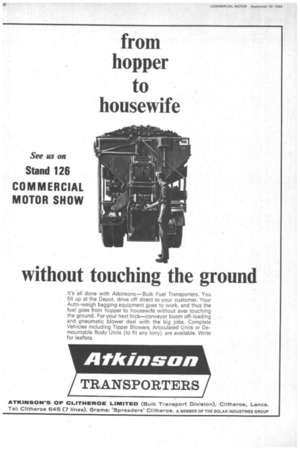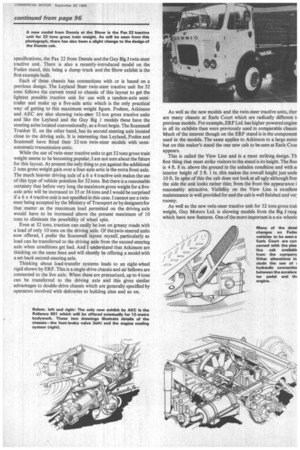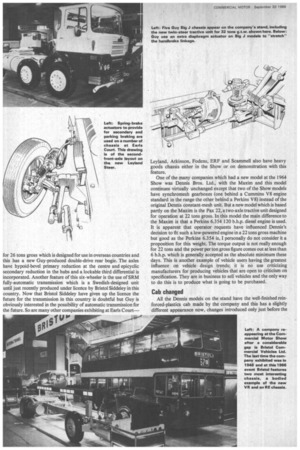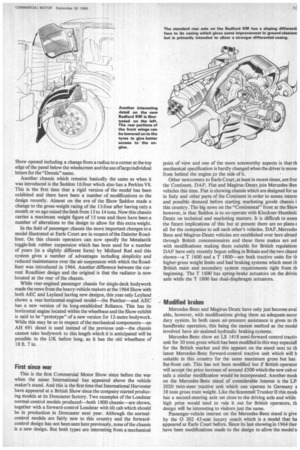without touching the ground
Page 102

Page 103

Page 104

Page 105

Page 106

If you've noticed an error in this article please click here to report it so we can fix it.
It's all done with Atkinsons—Bulk Fuel Transporters. You fill up at the Depot, drive off direct to your customer. Your Auto-weigh bagging equipment goes to work, and thus the fuel goes from hopper to housewife without ever touching the ground. For your next trick—conveyor boom off-loading and pneumatic blower deal with the big jobs. Complete Vehicles including Tipper Blowers, Articulated Units or Demountable Body Units (to fit any lorry) are available. Write for leaflets.
specifications, the Pax 22 from Dennis and the Guy Big J twin-steer tractive unit. There is also a recently-introduced model on the Foden stand, this being a dump truck and the Show exhibit is the first example built.
Each of these chassis has connections with or is based on a previous design. The Leyland Steer twin-steer tractive unit for 32 tons follows the current trend to chassis of this layout to get the lightest possible tractive unit for use with a tandem-axle semitrailer and make up a five-axle artic which is the only practical way of getting to this maximum weight figure. Fodens, Atkinson and AEC are also showing twin-steer 32-ton gross tractive units and like the Leyland and the Guy Big J models these have the steering axles located conventionally, as a front bogie. The Sammie11 Trunker II, on the other hand, has its second steering axle located close to the driving axle. It is interesting that Leyland, Foden and Scammell have fitted their 32-ton twin-steer models with semiautomatic transmission units.
While the use of twin-steer tractive units to get 32 tons gross train weight seems to be becoming popular, lam not sure about the future for this layout. At present the only thing to put against the additional 2 tons gross weight gain over a four-axle artic is the extra front axle. The much heavier driving axle of a 6 x 4 tractive unit makes the use of this type of vehicle pointless for 32 tons. But there is a reasonable certainty that before very long the maximum gross weight for a fiveaxle artic will be increased to 35 or 36 tons and! would be surprised if a 6 x 4 tractive unit is not specified in this case. I cannot see a twinsteer being accepted by the Ministry of Transport or by designers for that matter as the maximum load permitted on the driving axle would have to be increased above the present maximum of 10 tons to eliminate the possibility of wheel spin.
. Even at 32 tons, traction can easily be lost on greasy roads with a load of only 10 tons on the driving axle. Of the twin-steered units now offered, I prefer the Scammell layout myself, particularly as load can be transferred to the driving axle from the second steering axle when conditions get bad. And I understand that Atkinson are thinking on the same lines and will shortly be offering a model with a set-back second-steering axle.
Thinking about load-transfer systems leads to an eight-wheel rigid shown by ERF. This is a single-drive chassis and air bellows are connected to the live axle. When these are pressurized, up to 4 tons can be transferred to the driving axle and this gives similar advantages to double-drive chassis which are generally specified by operators involved with deliveries to building sites and so on. As well as the new models and the twin-steer tractive units, ther are many chassis at Earls Court which are radically different ti previous models. For example, ERF Ltd. has higher-powered engine in all its exhibits than were previously used in comparable chassit Much of the interest though on the ERF stand is in the component used in the models. The same applies to Atkinson to a large exten but on this maker's stand the one new cab to be seen at Earls Cow appears.
This is called the View Line and is a most striking design. Th first thing that must strike visitors to the stand is its height. The floo is 4 ft. 8 in. above the ground in the unladen condition and with ai interior height of 5 ft. 1 in. this makes the overall height just unde 10 ft. In spite of this the cab does not look at all ugly although fron the side the unit looks rather thin; from the front the appearance i reasonably attractive. Visibility on the View Line is excellent maintenance is well provided for and the cab is well finished and ver roomy.
As well as the new twin-steer tractive unit for 32 tons gross traii weight, Guy Motors Ltd. is showing models from the Big .1 rang which have new features. One of the more important is a six-wheele for 26 tons gross which is designed for use in overseas countries and this has a new Guy-produced double-drive rear bogie. The axles have hypoid-bevel primary reduction at the centre and epicyclic secondary reduction in the hubs and a lockable third differential is incorporated. Another feature of this six-wheeler is the use of SRM fully-automatic transmission which is a Swedish-designed unit until just recently produced under licence by Bristol Siddeley in this country. Now that Bristol Siddeley have given up the licence the future for the transmission in this country is doubtful but Guy is obviously interested in the possibility of automatic transmission for the future. So are many other companies exhibiting at Earls Court—
Leyland, Atkinson, Fodens, ERF and Scammell also have heavy goods chassis either in the Show or on demonstration with this feature.
One of the many companies which had a new model at the 1964 Show was Dennis Bros. Ltd., with the Maxim and this model continues virtually unchanged except that two of the Show models have synchromesh gearboxes (one behind a Cummins V8 engine standard in the range the other behind a Perkins V8) instead of the original Dennis constant-mesh unit. But a new model which is based partly on the Maxim is the Pax 22, a two-axle tractive unit designed for operation at 22 tons gross. In this model the main difference to the Maxim is that a Perkins 6.354 120 b.h.p. diesel engine is used. It is apparent that operator requests have influenced Dennis's decision to fit such a low-powered engine in a 22 tons gross machine but good as the Perkins 6.354 is, I personally do not consider it a proposition for this weight. The torque output is not really enough for 22 tons and the power per ton gross figure comes out at less than 6 h.h.p. which is generally accepted as the absolute minimum these days. This is another example of vehicle users having the greatest influence on vehicle design trends; it is no use criticizing manufacturers for producing vehicles that are open to criticism on specification. They are in business to sell vehicles and the only way to do this is to produce what is going to be purchased.
Cab changed
All the Dennis models on the stand have the well-finished reinforced-plastics cab made by the company and this has a slightly different appearance now, changes introduced only just before the Show opened including a change from a radius to a corner at the top edge of the panel below the windscreen and the use oflarge individual letters for the "Dennis" name.
Another chassis which remains basically the same as when it was introduced is the Seddon 16:four which also has a Perkins V8. This is the first time that a rigid version of the model has been exhibited and there have been a number of modifications to the design recently. Almost on the eve of the Show Seddon made a change to the gross-weight rating of the 13:four after having only a month or so ago raised the limit from 13 to 14 tons. Now this chassis carries a maximum weight figure of 15 tons and there have been a number of alterations to the design to allow for this extra weight.
In the field of passenger chassis the more important changes to a model illustrated at Earls Court are in respect of the Daimler Roadliner. On this chassis operators can now specify the Metalastik toggle-link rubber suspension which has been used for a number of years (in a slightly different form) by Midland Red and this system gives a number of advantages including simplicity and reduced maintenance over the air-suspension with which the Roadliner was introduced in 1964. Another difference between the current Roadliner design and the original is that the radiator is now located at the rear of the chassis.
While rear-engined passenger chassis for single-deck bodywork made the news from the heavy-vehicle makers at the 1964 Show with both AEC and Leyland having new designs, this year only Leyland shows a rear-horizontal-engined model—the Panther—and AEC has a new version of its long-established Reliance. This has its horizontal engine located within the wheelbase and the Show exhibit is said to be "prototype" of a new version for 12-metre bodywork. While this may be so in respect of the mechanical components—an AH 691 diesel is used instead of the previous unit—the chassis cannot take bodywork to this length which it is anticipated will be possible in the UK before long, as it has the old wheelbase of 18 ft. 7 in.
First since war This is the first Commercial Motor Show since before the war when the name International has appeared above the vehicle maker's stand. And this is the first time that International Harvester have appeared at a British Show since the company started producing models at its Doncaster factory. Two examples of the Loadstar normal-control models produced—both 1800 chassis—are shown, together with a forward-control Loadstar with tilt cab which should be in production in Doncaster next year. Although the normalcontrol models are fairly new to this country and the forwardcontrol design has not been seen here previously, none of the chassis is a new design. But both types are interesting from a mechanical point of view and one of the more noteworthy aspects is that th mechanical specification is hardly changed when the driver is move from behind the engine ito the side of it. Other newcomers to Earls Court, at least in recent times, are fror the Continent. DAF, Fiat and Magirus-Deutz join Mercedes-Ben vehicles this time. Fiat is showing chassis which are designed for us in Italy and other parts of the Continent in order to assess intere; and possible demand before starting marketing goods chassis i this country. The big news on the "Continental" front at the Shom however, is that Seddon is to co-operate with Klockner-Humbolc Deutz on technical and marketing matters. It is difficult to asses the future implications of this but at present there are no plans a all for the companies to sell each other's vehicles. DAF, Mercede; Benz and Magirus-Deutz vehicles are established over here ahead through British concessionaires and these three makes are sol with modifications making them suitable for British regulation; DAF have only recently begun selling in Britain and the two chassi shown—a T 1600 and a T 1800—are both tractive units for th higher-gross weight limits and had braking systems which meet th British main and secondary system requirements right from th beginning. The T 1600 has spring-brake actuators on the drivin axle while the T 1800 has dual-diaphragm actuators.
Modified brakes Mercedes-Benz and Magirus-Deutz have only just become avai able, however, with modifications giving them an adequate secor dary system. In both cases air-pressure assistance is given to th handbrake operation, this being the easiest method as the model involved have air-assisted-hydraulic braking systems.
Mercedes-Benz show an LS 1418 semi-forward control tractiv unit for 30 tons gross which has been modified in this way especiall for the British market and this appears on the stand next to th latest Mercedes-Benz forward-control tractive unit which will b suitable in this country for the same maximum gross but has flat-front cab. This has not been modified but if British operator will accept the _price increase of around £500 which the new cab er tails a similar modification would be incorporated. Another mod( on the Mercedes-Benz stand of considerable interest is the LP: 2020 twin-steer tractive unit which can operate in Germany a 38 tons gross train weight. Like the Scammell Trunker II this mod( has a second-steering axle set close to the driving axle and while high price would tend to rule it out for British operators, th design will be interesting to visitors just the same.
Passenger-vehicle interest on the Mercedes-Benz stand is give by the 0 302 43-seat luxury coach which is a model that ha appeared at Earls Court before. Since its last showing in 1964 ther have been modifications made to the design to allow the model ti omply to British p.s.v. regulations and the final hurdle will be when ur regulations are changed in respect of ground clearance—the I 302 does not comply at the front axle. I am told that a chassis as been through the Ministry of Transport test for a certificate of tness which it passed except for the ground clearance point.
There are three chassis on the Magirus-Deutz stand, one of them tractive unit for up to 36 tons gross train weight which has been )1c1 in this country, while the other is again a two-axle tractive nit but to the latest Magirus-Deutz design with a tilt-cab and ifferent engine. The third chassis on the Magirus-Deutz stand is a x-wheeler for 22 tons gross solo and this is a model specially eveloped for sale in Britain. This chassis also has the latest tilt-cab rhich differs from the previous design in that it has a square frontal ppearance instead of being slightly curved. One other new face at Earls Court is Hino Motors Ltd. from Japan, this maker being represented by the Dutch firm that now assembles Hino chassis for sale in Europe. There are no plans to export to Britain but this could be possible within the next year or so. Only one chassis appears on the stand, this being an attractive medium-weight vehicle which has a payload and body allowance of around 6 tons. A tilt-cab is used on the chassis and it is interesting that the doors are hung on the rear pillars.
To assess interest As I have already said, Fiat is using Earls Court to assess interest and future prospects of sales in Britain for its range of models and there are four examples on the stand, three tractive units and a two-axle rigid. I was able just before the Show to go to Italy to test one of the models being shown (a 693 T tractive unit for 38 tons gross) and gained a very favourable impression of the vehicle. One of the strongest impressions was of quietness and anyone who heard the vehicles being shunted around Earls Court when the Fiat stand was being made ready must agree. The Fiat chassis are robustly built and have braking systems which include independent circuits—either hydraulic or air-pressure according to the model—to each axle. But one of the points that is worrying Fiat is that they may have to modify the brakes to meet the British requirements if they begin to sell in this country. From what! heard at the Show they are very likely going to have nothing to worry about for I was told—and had it confirmed—that changes in the regulations were imminent under which "split" systems are going to be accepted in meeting the main and secondary brake efficiency requirements regardless of gross weight. At present only chassis grossing less than 12 tons are accepted as meeting the law by having independent circuits to separate axles and when this weight limit is removed it will make a complete nonsense of the work done by brake designers in incorporating additional secondary brake systems on vehicles designed for operation at the increased weight limits introduced in 1964. It will also make the work done by Mercedes-Benz and Magirus-Deutz already quite pointless and I fail to see why it has taken two years to realize that vehicles having independent circuits for their front and rear axles can give the same degree of safety as a chassis having an additional system built in, provided that a minimum efficiency requirement is met by each circuit on its own.
















































































































































































































